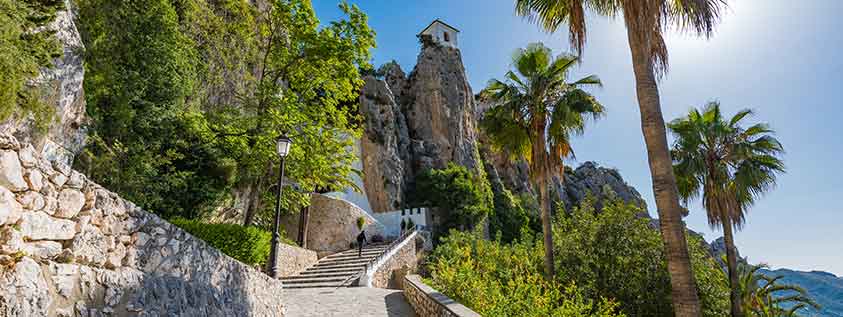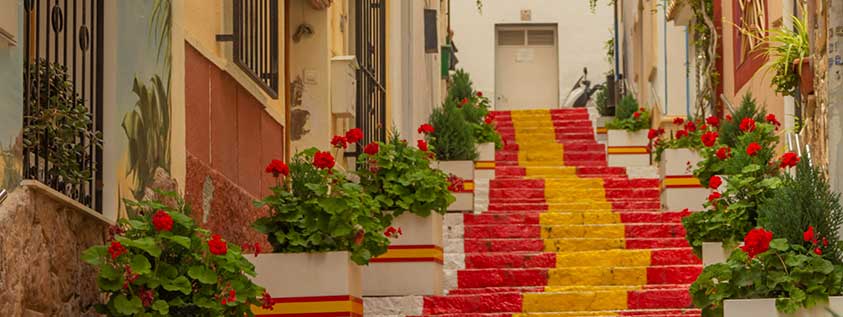Most Common Plants in Spain
As a country blessed with diverse climates and landscapes, the plants in Spain are as varied and stunning as its people. The combination of warm Mediterranean Sea temperatures, fertile soils, and different weather systems means that all manner of flora can be found in this captivating European nation. From ancient olive trees to colorful flowers, if you are looking for something extraordinary, then a stroll through Spain’s greenery will satisfy your plant cravings.
Let us look at some of the most common plants you may come across during your travels around Spain. Read on to discover more about the vegetation native to this wonderful country.
Content
What is the national plant of Spain?
The carnation is Spain’s national flower, also known as dianthus caryophyllus. It symbolizes deep love, respect, good luck, and admiration. Spanish culture has long used its flower to celebrate special occasions such as weddings and anniversaries. It is also the national flower of Portugal and Monaco.
Carnations are annuals easy to grow with full sun and moderately moist soil. They come in various colors, from white to pink and even purple. It often grows wild throughout Spain, adding color and beauty to the local landscapes.
What Are the Native Plants of Spain?
Here is a list of some of the most common plants and trees that you will find in Spain:

Spanish Sunflower
It is a perfect choice for those wanting to add some color and an exotic flair to their garden. The sunflower populates some areas more than others; in some regions, sunflowers can reach up to three meters in height. There are 3 routes to view sunflower fields in Spain: Bureba, Soria and Malaga.
The flowering is double (annual). In the month of August, the plant shows its full maturity, and its flowers are most beautiful. In autumn, the sunflower seeds are harvested.
Aloe Vera
This succulent plant species has been used medicinally as far back as the 16th century and is native to Spain, particularly in the Canary Islands. The leaves of this plant are often plucked from the base and used for topical treatments and drinks.
Climbing Plants
If you want to transform an outdoor space into a vibrant garden, consider investing in climbing plants like Bougainvillea. These thrive in Spain’s warm climates and produce beautiful flowers which attract bees, butterflies, and birds.
Bee Orchid
The name of this beautiful flower says it all! It is native to Spain and loves the full sun that is enjoyed in the country. It can be planted straight into the ground or potted indoors for a showy display.
Oak tree
The iconic oak tree is native to Spain and can be found in wooded areas nationwide. It loves warm temperatures, full sun and well-drained soil. Also, its wood is highly appreciated for its hardness, its resistance to humidity and its unquestionable aesthetic value.
Pine tree (Pinus)
Pine trees are also popular across Spain and can be found in subtropical regions with plenty of sunshine throughout the year. They love dry climates and need regular watering to thrive.
More plants that you can find in Spain
The following plants in Spain are indoor and outdoor plants great for Mediterranean Garden designs and can be found in local garden centers.
Golden pothos
The golden pothos is a popular flowering house plant common in Australia, Asia, and the West Indies. It goes by many nicknames, including “Devil’s Ivy,” “Taro Vine,” and “Scindapsus Aureus.” The golden pothos has glossy, heart-shaped leaves and can grow in the dark. Golden pothos has poisonous sap, so they should be kept away from pets and children.
Plumbago
The plumbago is a popular garden plant with deep blue flowers and bright green foliage. It grows rapidly in full sun and prefers moist soil, making it perfect for Spanish gardens. Plumbago is thought to have medicinal properties, such as treating respiratory diseases and back pain so it’s becoming increasingly popular.
The flowers possess tiny hairs that produce sticky materials that capture insects and ant flies, which prevent the destruction of their habitat. Initially, they seem fragile but grow in well-drained, durable soils without needing daily water. It will climb as well as the bushes, adding color to blank walls and creating interest.
Hibiscus
With hundreds of species, this genus of flowering plant – part of the mallow family – is found across temperate, warm, and subtropical regions worldwide. Easily identifiable for their vibrant trumpet-shaped blooms, these plants add color to everything from hedges and balconies to shopping streets and motorways in Spain.
The trumpeting hibiscus flower boasts a vibrant spectrum of color, typically with an eye-catching dark or contrasting center. From dainty pale pinks to electrifying fuchsias and oranges, these exotic blooms can be found flourishing in gardens across Spain.
Additionally, Hibiscus tea is a beloved beverage in Mexico and Central America, yet its popularity extends to Spain and beyond. The vibrant red-brown blend of dried hibiscus flowers boasts an inviting aroma and purported health benefits and calming effects; whether you choose to imbibe it hot or cold, this thirst-quenching elixir delivers the ultimate refreshment on sweltering days spent gardening under the Spanish sun.
Cycas
Although they may seem familiar, cycas are actually part of an ancient botanical family called Cycadophyta. It is different from palms, ferns, trees, or any other group of plants that we typically recognize today. They thrive throughout Spain and create a stunning visual display when planted in courtyards or landscaped gardens. These unique shrubs can also be successfully grown indoors in pots–perfect for those living in subtropical climates who want to experience the beauty of this age-old plant lineage.
Despite their slow growth rate, Cycas are easily found in the south of Spain and look similar to palm trees; with feathery foliage and trunk cones. They can be grown indoors but need premium outdoor conditions for optimal survival – temperatures below freezing will cause irreparable damage to their leaves which is why it’s not as popular in Northern Spain.
Hypericum
These evergreen shrubs, better known as St. John’s Wort, have long been used for medicinal purposes. The hypericum plants boast a vast range of colors, from vibrant orange and yellow to deep purples and reds, making them ideal for brightening dull spaces in your garden. They are easily found in garden centers throughout Spain and are incredibly low-maintenance plants, requiring very little water for survival.
Unlike most flowering plants, hypericum will prosper even in areas with poor soil conditions or minimal sunlight. These resilient shrubs can flourish without much watering if the weather is relatively mild. However, they do require regular pruning to maintain their shape and prevent the plants from becoming overgrown. Perfect for novice gardeners, these hardy plants will reward your efforts with stunningly vibrant blooms that last all summer long.
Lavender
With its charming blooms and unmistakable scent, this flowering plant has been beloved for centuries- not just for its versatility in cooking or medicine but simply as an attractive addition to any garden. For millennia its oil has been used for healing minor burns, insect bites, and swelling – all while providing an overall calming effect. This is why you’ll find this plant in Spain often added to soaps, bath bubbles, or sleep aids. Lavender also helps alleviate anxiety, depression, restlessness, or insomnia symptoms. Lavender is everywhere – from courtyards to restaurant fronts.
In the months of July and August, the lavender flower is at its peak. It is the perfect time to walk through the fields and enjoy them. Luckily, in Spain, there are countless lavender plantations where we can enjoy this new spectacle where the smell and color are the protagonists, from dawn to dusk. Some of the most common places to visit lavender fields in Spain are Murcia, Toledo and Valladolid.
Kalanchoe
Also known as Widow’s-thrill, this succulent plant in Spain hails from southern Africa and Madagascar and is known for its unique shape. Its fleshy leaves are filled with a juicy gel-like substance that holds moisture, an adaptation to the arid climates from where it originates. Kalanchoe plants can be found in an array of colors, ranging from peach and yellow to magenta and blue; so no matter what style you prefer, there’s sure to be a variety that will suit your taste.
Kalanchoe plants boast thick, rubbery leaves and breathtaking clusters of vibrant flowers. Not only can they be grown outdoors or indoors on balconies in pots, but their leaves are designed to soak up water and distribute it throughout the plant based on its needs – making them easy to care for.
Succulents and Cacti
The most popular of all plants in Spain, succulents and cacti are incredibly versatile and can be used both indoors and outdoors. Cactus and Succulents thrive in the afternoon sunshine all over the globe. These Spain plants also survive cooler weather very well. Other succulents include Agave, Aloe echeveira, Euphorbia, and Sedum.
Passiflora
Passiflora, otherwise known as passion flowers are plants in Spain renowned for their fascinating appearance. These tendril-climbing vines and shrubs flourish in balmy conditions like those in Spain; however, it is advisable to protect this plant from harsher climates.
Even without its succulent fruit, Passiflora still catches the eye with its palmate leaves made up of five or more lobes. The flower has a stunning lilac center with an impressive fringe of filaments in shades of blue, white, and purple.

A word from SpainDesk
Spain has some of the most intriguing and unique plant varieties in the world. From house plants to outdoor plants, you can find the perfect plant for your home or garden. Whether you are looking for a showy flower, vibrant succulent, or climbing vines, there is something for everyone in Spanish gardens. With their hardy nature and ability to thrive in warm climates, many species of plants can be found in both northern and southern Spain as well as its islands.

